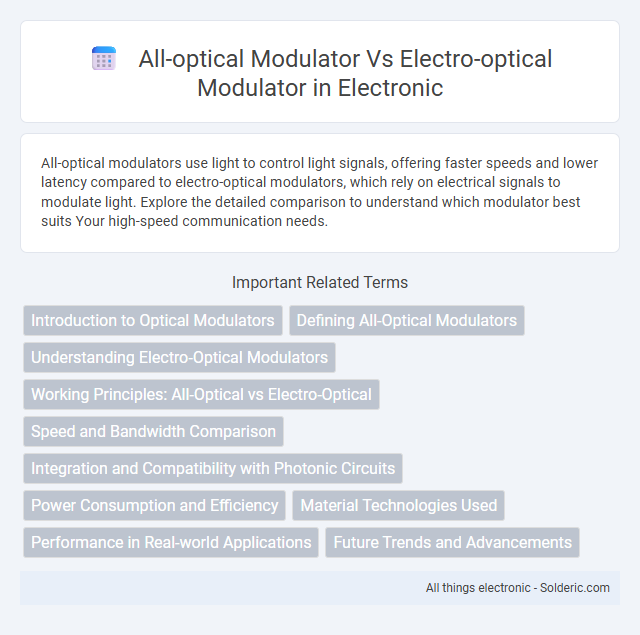All-optical modulators use light to control light signals, offering faster speeds and lower latency compared to electro-optical modulators, which rely on electrical signals to modulate light. Explore the detailed comparison to understand which modulator best suits Your high-speed communication needs.
Comparison Table
| Feature | All-Optical Modulator | Electro-Optical Modulator |
|---|---|---|
| Operation Principle | Modulates light using light itself (optical control signal) | Modulates light using electrical signals |
| Speed | Ultrafast, limited mainly by optical nonlinearities | High speed, limited by electronic bandwidth |
| Integration | Challenging, emerging photonic integration technologies | Well-established in integrated photonics and silicon photonics |
| Energy Efficiency | Potentially lower energy per bit due to direct optical control | Higher energy consumption due to electrical drive circuits |
| Applications | All-optical signal processing, ultrafast switching | Telecommunications, optical data transmission, signal modulation |
| Complexity | High optical complexity, alignment-sensitive | Electrical control simplifies integration and scalability |
| Bandwidth | Extremely broad, limited by optical materials | Broad, but limited by electronic components |
Introduction to Optical Modulators
Optical modulators are crucial components in photonics, enabling the control of light signals for communication and signal processing. All-optical modulators manipulate light using another light beam, offering ultrafast speeds and reduced electrical interference, while electro-optical modulators rely on an electric field to alter the refractive index of a material, modulating the light intensity or phase. Your choice between these modulators depends on application requirements like speed, integration, and signal fidelity in optical networks.
Defining All-Optical Modulators
All-optical modulators manipulate light signals directly using another light beam without converting to electrical signals, enabling ultrafast signal processing and minimizing latency. In contrast, electro-optical modulators rely on electrical signals to control light modulation, which introduces conversion delays and energy loss. You benefit from all-optical modulators in high-speed optical communication systems where bandwidth and response time are critical.
Understanding Electro-Optical Modulators
Electro-optical modulators use electric fields to control the phase, amplitude, or polarization of light waves, making them essential in high-speed optical communication systems. These modulators rely on materials like lithium niobate, which exhibit the Pockels effect for rapid modulation with low insertion loss and high bandwidth. Understanding electro-optical modulators helps you optimize signal encoding and improve the performance of optical networks compared to all-optical modulators that manipulate light purely through optical signals.
Working Principles: All-Optical vs Electro-Optical
All-optical modulators control light signals by using one optical beam to modulate another, relying on nonlinear optical effects like cross-phase modulation or two-photon absorption, resulting in ultrafast signal processing without electrical conversion. Electro-optical modulators utilize an external electrical voltage to vary the refractive index of a material, such as lithium niobate, thereby modulating the intensity, phase, or polarization of the transmitted light through the electro-optic effect. Your choice between these modulators depends on the required speed, integration complexity, and application-specific performance in photonic devices.
Speed and Bandwidth Comparison
All-optical modulators offer ultra-fast speed and broad bandwidth due to their ability to modulate light signals directly without electronic conversion, making them ideal for high-speed optical communication systems. Electro-optical modulators typically exhibit slower response times and narrower bandwidths as they rely on electric fields to control light, which introduces electronic limitations. Your choice between these modulators impacts system performance in terms of data rate and signal integrity, with all-optical modulators excelling in environments demanding high-speed, wideband operation.
Integration and Compatibility with Photonic Circuits
All-optical modulators offer seamless integration with photonic circuits due to their reliance on light-based signal control, minimizing electrical interconnect complexity and enhancing signal speed. Electro-optical modulators require electronic control signals, necessitating additional electrical components that can complicate circuit design and increase insertion loss. Photonic circuit compatibility favors all-optical modulators for ultra-fast, low-latency applications, while electro-optical modulators remain prevalent where electronic interfacing and mature fabrication processes are prioritized.
Power Consumption and Efficiency
All-optical modulators exhibit significantly lower power consumption compared to electro-optical modulators, as they eliminate the need for electrical-to-optical signal conversion, thereby enhancing overall energy efficiency. These devices leverage nonlinear optical effects to modulate light directly, resulting in faster response times and reduced thermal dissipation. In contrast, electro-optical modulators typically require continuous electrical drive signals, increasing power usage and limiting efficiency in high-speed optical communication systems.
Material Technologies Used
All-optical modulators primarily utilize nonlinear optical materials such as silicon photonic crystals, graphene, and chalcogenide glasses to manipulate light signals without electrical input. Electro-optical modulators often rely on materials like lithium niobate, indium phosphide, and gallium arsenide, which exhibit strong electro-optic effects for converting electrical signals into optical modulation. The choice of material directly impacts modulation speed, insertion loss, and integration capability within photonic circuits.
Performance in Real-world Applications
All-optical modulators offer ultrafast switching speeds and lower signal distortion, making them ideal for high-bandwidth communication systems and data centers where latency and signal integrity are critical. Electro-optical modulators, while slightly slower, provide greater compatibility with existing electronic control systems and are often preferred in integrated photonic circuits for their precise modulation control. Your choice depends on whether application demands prioritize speed and signal quality or system integration and control flexibility.
Future Trends and Advancements
Future trends in all-optical modulators emphasize ultrafast data transmission and low power consumption, leveraging materials like graphene and silicon photonics for enhanced integration and bandwidth. Electro-optical modulators continue to advance with improved modulation speeds and energy efficiency through innovative designs such as lithium niobate on insulator (LNOI) platforms and organic polymers. Your choice between these modulators will depend on specific application needs, balancing the demand for higher data rates and seamless integration into photonic circuits.
All-optical modulator vs electro-optical modulator Infographic

 solderic.com
solderic.com